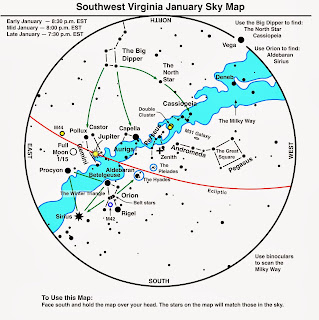January Sky
Early January - 8:30 p.m. (EST)
Late January - 7:30 p.m. (EST)
Perihelion: Earth reaches its closest annual distance to the sun on January 4 at 91.4 million miles away.
Quadrantid Meteor Shower: in the northeast after 3 a.m. on January 3, over 60 meteors per hour.
Visible Planets:
MERCURY very low in the west-southwest forty minutes after sun set after January 23.
VENUS very low in the west-southwest forty minutes after sunset until January 3. Behind the sun on January 11. Low in the east-southeast forty minutes before sunrise after January 19. Below the crescent Moon on January 2 at 5:45 p.m.
MARS rises in the east before 1 a.m. at the beginning of January and before midnight at the end of the month. Above the moon and the star Spica on January 23 at 3 a.m.
JUPITER rises in the east-northeast at sunset, and is visible all night. Next to the bright waxing gibbous moon on January 14.
SATURN rises in the east-southeast before 4 a.m. at the beginning of the January and before 2 a.m. by the end of the month. Directly next to the waning crescent moon on January 25 at 5 a.m.
Use the Big Dipper to locate:
The North Star
Capella
Pollux and Castor
Use Orion's Belt to locate:
Aldebaran
Sirius
To use this map:
Face south and hold the map above your head. The stars on the map will match those in the sky.
Such is our view from Earth…
